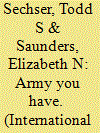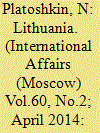| Srl | Item |
| 1 |
ID:
096693


|
|
|
|
|
| Publication |
2010.
|
| Summary/Abstract |
Recent research suggests that a crucial factor in understanding the outcomes of military conflicts is the extent to which militaries are mechanized-that is, their relative dependence on tanks and armored vehicles compared to manpower. Since World War II, militaries have become increasingly mechanized both among the great powers and in unexpected quarters of the developing world. Yet the extent of military mechanization varies widely across states. Why have some states adopted highly mechanized force structures, while others have not? This paper tests several hypotheses about the determinants of military mechanization. One perspective suggests that strategic factors-including the force structures of adversaries and neighbors, recent combat lessons, and internal insurgency threats-shape a military's mix of manpower and vehicles. A second set of hypotheses points instead to domestic institutions such as democracy and civilian control of the military. Still other theories emphasize economic forces and international norms. To test these and other hypotheses, we construct a new data set containing mechanization rates for more than 150 militaries from 1979 to 2001. Broadly, we find significant support for the strategic perspective and little support for domestic institutional explanations. In addition, the results suggest systematic and predictable differences in the ways states structure their militaries in response to security pressures.
|
|
|
|
|
|
|
|
|
|
|
|
|
|
|
|
| 2 |
ID:
072702


|
|
|
|
|
| Publication |
2006.
|
| Summary/Abstract |
This article examines the role of NATO in aiding democratic transitions and survival in the former Soviet republics. The authors argue that the level of external threat is a determining factor in centralization, militarization, and ultimately regime type. States tend to be democratic or are likely to make the transition toward democracy when threat levels are low, while autocracies are more likely to be found in states targeted by higher levels of threat. Building on recent findings examining the link between democracies and alliance, the authors demonstrate that NATO has been an effective guarantor of territorial sovereignty and independence in the Baltic states, Ukraine, and Moldova, reducing the level of threat experienced by each state, thus assuring the survival of decentralized and democratic governments. Former Soviet republics targeted by high levels of threat have reverted to or maintained centralized, autocratic forms of government.
|
|
|
|
|
|
|
|
|
|
|
|
|
|
|
|
| 3 |
ID:
130850


|
|
|
|
|
| Publication |
2014.
|
| Summary/Abstract |
In November 2013, Ukraine and several other former Soviet Republics declined and association with the European Union at the Vilnius Summit of Eastern Partnership.
|
|
|
|
|
|
|
|
|
|
|
|
|
|
|
|